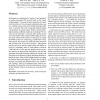Free Online Productivity Tools
i2Speak
i2Symbol
i2OCR
iTex2Img
iWeb2Print
iWeb2Shot
i2Type
iPdf2Split
iPdf2Merge
i2Bopomofo
i2Arabic
i2Style
i2Image
i2PDF
iLatex2Rtf
Sci2ools
IWQOS
2004
Springer
2004
Springer
Small world overlay P2P networks
In this paper, we consider how to “construct” and “maintain” an overlay structured P2P network based on the “smallworld paradigm”. Two main attractive properties of a smallworld network are (1) low average hop distance between any two randomly chosen nodes and, (2) high clustering coefficient. A network with a low average hop distance implies a small latency for object lookup. While a network with a high clustering coefficient implies the underlying P2P network has the “potential” to provide object lookup service even in the midst of heavy object traffic loading, for example, under a flash crowd scenario. In this paper, we present the SWOP protocol of constructing a small-world overlay P2P network. We compare our result with other structured P2P networks such as the Chord protocol. Although the Chord protocol can provide object lookup with latency of ¢¤£¦¥¨§©£ complexity, where is the number of nodes in a P2P network, we show that the SWOP protoc...
| Added | 02 Jul 2010 |
| Updated | 02 Jul 2010 |
| Type | Conference |
| Year | 2004 |
| Where | IWQOS |
| Authors | Ken Y. K. Hui, John C. S. Lui, David K. Y. Yau |
Comments (0)

